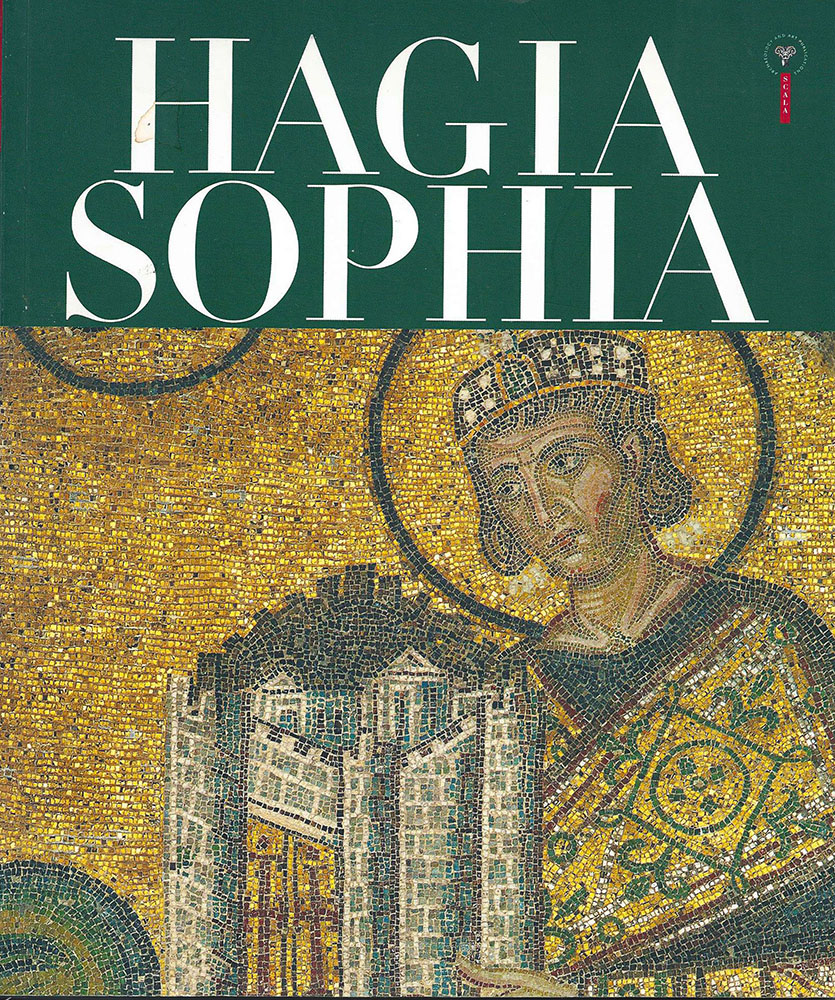
Hagia Sophia, Scala Publishers London 2004
Co-authored with W. Eugene Kleinbauer and Antony White
In association with Art and Archaeology Press, Istanbul
Hagia Sophia is one of the world’s greatest architectural monuments. First constructed as the principal church of Constantinople in the fourth century, and destroyed twice by fire, it was rebuilt in the mid-sixth century. Its soaring domes and arches, adorned with luminous gold mosaic-work and gleaming marbles, have inspired awe among generations of visitors. Following the Ottoman conquest of Constantinople in 1453, the church was divested of its Christian decoration and converted to a mosque. It ranked as one of the most important imperial mosques in Istanbul until 1935, when it was converted into a museum. This fully illustrated guide traces the building’s development from its foundation as the principal church of Constantinople in the fourth century to its present role as a museum. The beautiful images and design pay tribute to the famous and awe-inspiring architecture.
Table of Contents
The Church of Justinian by W. Eugene Kleinbauer
Mosaic Decoration of the Byzantine Period by Antony White
From the Fifteenth Century to the Present Day by Henry Matthews
- Introductions
- Muslim Ambitions and Desires for the Possession of Hagia Sophia
- Conversion of Hagia Sophia to a Mosque
- Covering the Mosaics
- The Minarets
- Mimar Sinan’s Improvements in the Reign of Selim II
- The Tombs
- Additions by Murat III and Mahmut I
- The Fossati Restoration
- The Calligraphy
- Hagia Sophia Declared a Museum
- The Current restoration
- The Influence of Hagia Sophia on Ottoman Mosques
First page of my article
From the Fifteenth Century to the Present Day Henry Matthews
On 29 May 1453 Mehmet II, the conqueror of Constantinople, made his triumphal entry into the city after a 54-day siege. He rode almost at once to the ancient Byzantine cathedral of Hagia Sophia. In an act of humility before he entered, he dismounted, prostrated himself and put soil upon his head. As he passed through the bronze doors into the vast domed interior he saw a man hacking at the marble paving in an attempt to prize up a stone. The sultan rebuked the miscreant, demanding his purpose. When the man replied that this was but a temple for infidels, Mehmet reproved him, asked his soldiers to put an end to all looting, and proclaimed that the church would become a mosque. The possession of Constantinople had been one of the most important goals of Muslims since the time of Muhammad, and Hagia Sophia stood out brightly in the city as the jewel in the crown. Mehmet, known to his people as Fatih (Conqueror) was not a victor who would destroy the cities he conquered, and massacre their people; he perceived himself as an inheritor of the throne of Constantine the Great. Since Muslims regarded Jesus Christ as a prophet of their own religion, the era of Byzantine Christianity could be interpreted as the harbinger of a golden age for Islam. Mehmet believed that the Byzantine emperors who embellished and fortified the city for more than a thousand years had paved the way for him as the supreme emperor and defender of the Islamic faith. When he commanded an imam to mount the pulpit and proclaim: ‘There is no God but God. Muhammad is God’s Prophet’, he was fulfilling a sacred duty. On this fateful day he inaugurated Hagia Sophia’s span of almost 5oo years as a mosque. After the former church had been converted for Islamic worship, it was constantly admired; a succession of sultans repaired, embellished and made additions to it. Hagia Sophia was also emulated as a source for the design of mosques and accepted as a challenge to ambitious sultans and their architects. Finally in 1935, under Atattirk, it became a museum. This essay recounts the story of the Ottoman stewardship of Hagia Sophia, and its care under the’ modern Turkish state.
Muslim Ambitions and Desires for the Possession of Hagia Sophia Muhammad himself had prophesied that the first Muslim to pray in Hagia Sophia would go to paradise, and, from that time, Muslim leaders burned with desire to win the magnificent church. In 674, only forty-two years after the death of the Prophet, an Arab army began a siege of Constantinople that lasted four years. According to Ottoman legend, Muhammad’s companion and standard-bearer Eyiip Ensari, who took part in the campaign, received permission to pray in Hagia Sophia in exchange for ending the siege. After his prayers in the cathedral, he was treacherously murdered and became a martyr. Mehmet II, who miraculously discovered his bones, erected a shrine for him that became one of the most important Islamic pilgrim-age sites after Mecca and Medina. Arabs besieged Constantinople a second time from 717 to 718, but the still powerful Byzantine forces inflicted heavy losses on them and they abandoned the struggle. The decline of Byzantine power began with the crushing defeat of the imperial army by Seljuk Turks at the battle of Manzikert in 1071, and the empire was further diminished at the battle of Myriocephalon in 5575. By this time all Anatolia was in the hands of the Seljuks. The ravages of the Fourth Crusade (1202) destroyed any hope that the Byzantine Empire could regain its former glory. A renaissance in the thirteenth century under the Paleologues, and a revival of art and scholarship, was short-lived. The next century saw the founding of the Ottoman state, and the gradual encircling of Constantinople by Ottomans who made their capital at the nearby city of Bursa (1326) and then moved it to Edirne. (1362)